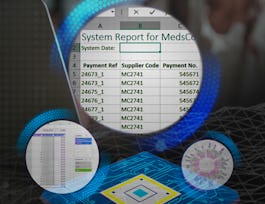As data becomes the modern currency, so the ability to analyse the data quickly and accurately has become of paramount importance. Excel with its extraordinarily broad range of features and capabilities is one of the most widely used programs for doing this. In the first course of our Excel Skills for Data Analysis and Visualization Specialization, you will learn the fundamentals of Excel for data analysis. When you have completed the course, you will be able to use a range of Excel tools and functions to clean and prepare data for analysis; automate data analysis with the help of Named Ranges and Tables; and use logical and lookup functions to transform, link and categorise data.


Excel Fundamentals for Data Analysis
This course is part of Excel Skills for Data Analytics and Visualization Specialization
Taught in English
Some content may not be translated


Instructors: Nicky Bull
161,079 already enrolled
Included with 
Course
(3,647 reviews)
96%
What you'll learn
Use Excel tools and functions to clean and prepare data for analysis.
Use Named Ranges and Tables to automate your analysis.
Understand the different types of data in Excel and use appropriate functions to work with them.
Use logical and lookup functions to transform, link and categorise data.
Skills you'll gain
Details to know

Add to your LinkedIn profile
31 quizzes
Course
(3,647 reviews)
96%
See how employees at top companies are mastering in-demand skills

Build your subject-matter expertise
- Learn new concepts from industry experts
- Gain a foundational understanding of a subject or tool
- Develop job-relevant skills with hands-on projects
- Earn a shareable career certificate


Earn a career certificate
Add this credential to your LinkedIn profile, resume, or CV
Share it on social media and in your performance review

There are 7 modules in this course
What's included
1 video3 readings1 discussion prompt
By the end of this module, you will be an expert in Excel's Text functions. This module discusses ways you can extract information and manipulate data to fulfil specific business requirements. You will develop techniques for working confidently with these Excel functions and unlock the full power of Excel by manipulating and cleaning text data. This is really important because you cannot properly analyse data if it is invalid or in an unsuitable format. You will begin with the mechanics of creating a function, specifying multiple arguments, and then you will look at how to work with text in functions. You will also learn how to use multiple functions in a single formula — a technique known as nesting. The topics you will be learning this week: Functions for Combining Text; Functions for Splitting Text; Combining Text Functions; Cleaning Data & Changing Case; and Removing and replacing unwanted characters.
What's included
6 videos4 readings6 quizzes
By the end of this module, you will be an expert in Excel's Date functions. This module discusses ways that you can extract information and manipulate data to fulfil specific business requirements. You will also be looking at functions for converting data types: such as text to numbers, dates to text, and then both numbers and text to dates. You will learn to solve the problem of data not being in the correct format, and you will learn how to perform arithmetic operations with dates like you would with numbers, as well as performing calculations with dates. You will also learn some really great functions specifically for solving day-to-day tricky date problems that are required in business such as the WORKDAY, EDATE and EOMONTH functions. The topics you will be learning this week: Converting Data Types; Understanding dates and basic date functions; Generating valid dates; Calculating days between two dates; and Calculating dates from a given date.
What's included
6 videos3 readings6 quizzes
In this module, you will learn about different types of cell referencing: relative cell referencing, absolute cell referencing, and mixed cell referencing. You will then learn about a great Excel functionality, Named Ranges — which is another way of referencing a cell or a range of cells by giving them a sensible name. You will see that named ranges make our formulas much easier to understand and you will also see how it makes them much easier to create — using tools such as Define Name and Create from Selection. You will also learn about Excel's Name Box and the Name Manager. You will learn some exciting Excel functions that allow you to aggregate and summarise data — such as SUMIFS and COUNTIFS, and much more. The topics you will be learning this week: Cell referencing and naming; Creating named ranges; Managing named ranges; Calculations with named ranges; and Automating processes with named ranges.
What's included
6 videos3 readings6 quizzes
In this module, you will learn that a table in Excel is more like a database of records and fields which contains a set of related information — such as a table of inventory data. You will learn how to create, format, and manage tables, and you will learn how to easily format, select, sort, and filter in a table. You will also learn about the Total Row where you can just pick from a set of automated summarisation functions. You will learn about structured referencing — where you can continue to work with the data in a table, but the formulas look slightly different because tables use a different way to reference cells. You will also learn how to automatically extend tables whenever new data is added. The topics you will be learning this week: Creating, naming and removing tables; Formatting and selecting in tables; Sorting and filtering tables; Performing calculations with structured references; and Automating processes with tables.
What's included
6 videos3 readings6 quizzes
You will learn two great Excel skills in this week’s module — first, you will learn about conditional logic, and second, you will learn about automating lookups. The two of these tools together will push your data analytics to the next level! Excel has several logical functions and this module explores some of them, such as AND, OR, and IF. You will start by learning the concept of conditional logic, and how conditional logic works in Excel formulas. You will then learn to conduct logic tests and use conditional operations. For more complex logic tree scenarios, you will learn how to use nested IF functions to evaluate data. You will then learn about lookup functions — these are widely used in data analytics for connecting data sets as well as error checking. You will learn about one of the most widely used lookup functions in business — VLOOKUP, as well as other lookup functions such as INDEX and MATCH, as well as Excel newest lookup function — XLOOKUP. The topics you will be learning this week: Performing logical operations with IF; Applying advanced logical operations; Categorising data with VLOOKUP; Matching data with VLOOKUP and XLOOKUP; and Advanced data matching with INDEX and MATCH.
What's included
6 videos3 readings6 quizzes
This is the final assessment of the course and it is worth 25% of your total grade. As this is the final assessment, it requires you to demonstrate the learning objectives from each of the weeks — and thus requires you to demonstrate all the learning objectives of the entire course.
What's included
1 quiz
Instructors


Offered by
Recommended if you're interested in Business Essentials

Macquarie University

Macquarie University

Macquarie University

Macquarie University
Why people choose Coursera for their career




Learner reviews
Showing 3 of 3647
3,647 reviews
- 5 stars
81.76%
- 4 stars
15.61%
- 3 stars
1.77%
- 2 stars
0.24%
- 1 star
0.60%
New to Business Essentials? Start here.

Open new doors with Coursera Plus
Unlimited access to 7,000+ world-class courses, hands-on projects, and job-ready certificate programs - all included in your subscription
Advance your career with an online degree
Earn a degree from world-class universities - 100% online
Join over 3,400 global companies that choose Coursera for Business
Upskill your employees to excel in the digital economy
Frequently asked questions
Access to lectures and assignments depends on your type of enrollment. If you take a course in audit mode, you will be able to see most course materials for free. To access graded assignments and to earn a Certificate, you will need to purchase the Certificate experience, during or after your audit. If you don't see the audit option:
The course may not offer an audit option. You can try a Free Trial instead, or apply for Financial Aid.
The course may offer 'Full Course, No Certificate' instead. This option lets you see all course materials, submit required assessments, and get a final grade. This also means that you will not be able to purchase a Certificate experience.
When you enroll in the course, you get access to all of the courses in the Specialization, and you earn a certificate when you complete the work. Your electronic Certificate will be added to your Accomplishments page - from there, you can print your Certificate or add it to your LinkedIn profile. If you only want to read and view the course content, you can audit the course for free.
If you subscribed, you get a 7-day free trial during which you can cancel at no penalty. After that, we don’t give refunds, but you can cancel your subscription at any time. See our full refund policy.

